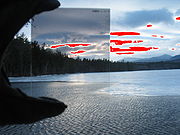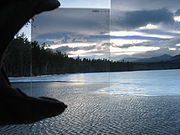
Graduated neutral density filter
Encyclopedia


Neutral density filter
In photography and optics, a neutral density filter or ND filter can be a colorless or grey filter. An ideal neutral density filter reduces and/or modifies intensity of all wavelengths or colors of light equally, giving no changes in hue of color rendition.The purpose of standard photographic...
which transitions, either abruptly or gradually, into the other half which is clear. It is used to bring an overly-bright part of a scene into the dynamic range
Dynamic range
Dynamic range, abbreviated DR or DNR, is the ratio between the largest and smallest possible values of a changeable quantity, such as in sound and light. It is measured as a ratio, or as a base-10 or base-2 logarithmic value.-Dynamic range and human perception:The human senses of sight and...
of film or sensor. For example, it can be used to darken a bright sky so that both the sky and subject can be properly exposed. ND filters can come in a variety of shapes and sizes and densities and can be used in all types of photographic applications from still photography, motion photography and scientific applications.
Center-spot filters are ND graduated filters that are slightly opaque in the center and are clear at edges. These are used for special effects or to compensate for light falloff that is natural with large optics.
History

Black-and-white
Black-and-white, often abbreviated B/W or B&W, is a term referring to a number of monochrome forms in visual arts.Black-and-white as a description is also something of a misnomer, for in addition to black and white, most of these media included varying shades of gray...
photography, and sometimes used a yellow top half to darken blue skies more. In a discussion at the Royal Photographic Society
Royal Photographic Society
The Royal Photographic Society is the world's oldest national photographic society. It was founded in London, United Kingdom in 1853 as The Photographic Society of London with the objective of promoting the Art and Science of Photography...
in 1910, some "debatants" held the use of such "graduated color screens" to be quite limited.
In more modern times, the use of graduated ND filters was popularized by Galen Rowell
Galen Rowell
Galen Avery Rowell was a noted wilderness photographer and climber. Born in Oakland, California, he became a full-time photographer in 1972.-Early life and education:...
. Singh-Ray
Singh-Ray
Singh-Ray Corporation, known as Singh-Ray Filters is an American maker of photographic filters based in Arcadia, Florida, and established in 1962.They are among the more expensive brands and have a reputation for high quality and personalized service...
sold them as "The Singh-Ray set of 4 Galen Rowell Graduated Neutral Density Filters."
Although its importance may have lessened with the advent of the modern digital darkroom
Digital darkroom
Digital "darkroom" is the hardware, software and techniques used in digital photography that replace the darkroom equivalents, such as enlarging, cropping, dodging and burning, as well as processes that don't have a film equivalent....
, graduated ND filters are still an important tool for professionals because a digital sensor that is clipping
Clipping (photography)
In digital photography and digital video, clipping is a result of capturing or processing an image where the intensity in a certain area falls outside the minimum and maximum intensity which can be represented. It is an instance of signal clipping in the image domain...
("blown out" or "washed out") captures no usable data in the clipped area, an effect which cannot be corrected with later processing because data has been lost.
Types

- Hard edge
- Soft edge
A hard edge is used when there is an abrupt change in brightness. For example a field with a horizon to a bright sky. A soft edge is a wider smoother change from light to dark. This is used when the light and dark portions are not distinctly separated. For example a mountain and sky. A soft edge filter is less noticeable than a hard edge. It also has the benefit of making the sky more intense, darkening the sky the closer on the top.
Below is a picture of what a hard edge and soft edge filter would look like.
External links
- Wikihowto: Howto add the effect of a graduated neutral density filter on a photo using the Gimp graphics editor
- Outdoor Photographer How To: Graduated Neutral-Density Filters
- Jesse Speer Photography >> Making the Image : Digital Graduated ND
- An effective demonstration picture on flickr.com, photo by www.saraheinrichs.com Gnd Filters simulation with Gimp.

